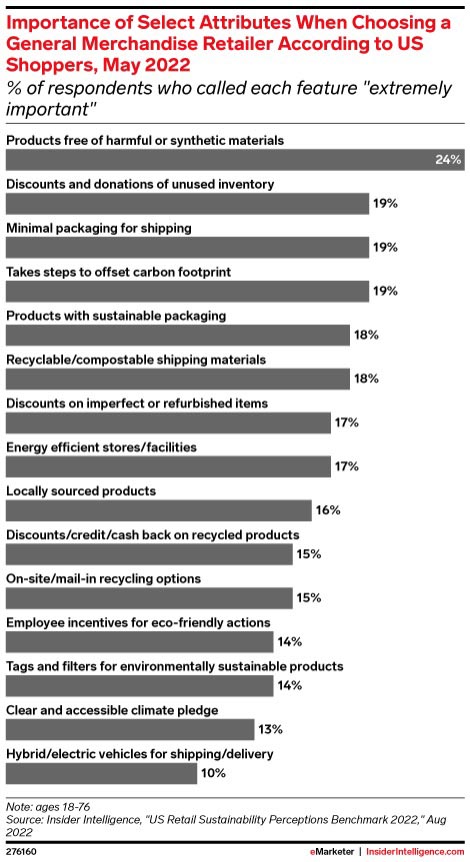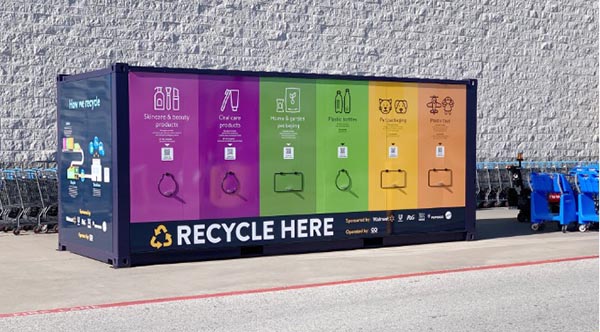Everywhere you look, brands are promoting their sustainability initiatives to woo a public that increasingly cares about the topic. Synthetic materials, excessive production, wasteful packaging, and carbon pollution—they were all high on shoppers’ lists of concerns. But caring about something and allowing it to influence their shopping decisions are two different things.
So how much do these values really impact how consumers buy? A recent report from eMarketer/Insider Intelligence, “U.S. Retail Sustainability Perceptions Benchmark 2022,” took a deep dive into this topic.
According to analyst and report author Blake Roche, the majority of people surveyed for the report indicated that they had purchased a product within the last six months because of some sort of sustainability feature. However, during the process of actually making those purchasing decisions, none of us would be surprised to hear that the study found that sustainability is rarely the deciding factor. For example, shoppers cited a variety of things (a brand not using synthetic materials, donating unused materials, and using minimal packaging) as “very important,” but when asked to pick their top three purchase motivators, attributes such as value, convenience, and “findability” ranked far higher.
“Only 13% of respondents said that a retailer's eco-friendly practices were a priority in-store and 14% said they were a priority online,” says Roche in the August 17, 2022 eMarketer podcast “Reimagining Retail.” “Compare this to ‘quality for the price,’ where 46% said that this was a priority in-store and 48% said it was a priority online. So while sustainability is important, it gets out-ranked pretty significantly by more practical concerns.”

This doesn’t mean that shoppers aren’t prioritizing sustainability at all, or that they aren’t willing to pay any sort of premium for eco-friendly products. It just means that sustainability’s relative level of influence over their purchases and shoppers’ tolerance for paying premiums for those products are lower than they have been in the past.
When Does Sustainability Influence Shopping Decisions?
When do sustainability elements actually influence shopping decisions? When they are things shoppers can see, feel, and experience directly, such as minimal packaging, a product/packaging’s recyclability, and the value shoppers see around resale or refurbished items. At the same time, as consumers pay more for gas and groceries, some categories, such as organics, are taking a hit.
But don’t make assumptions about which consumer groups are the most likely to allow this to influence their purchasing decisions. While it’s conventional wisdom that younger consumers are the most concerned about environmental issues, Insider Intelligence found that they tend to be less likely than older consumers to translate those concerns into action.
In part, Roche explains, this may be because this group has the least spending power. “There is this sense,” he says, “that it's not really up to me to be spending on things that are sustainable—it's the corporations selling these products that need to be taking on the bulk of the responsibility because I can't afford to.’”
This attitude is also impacted by younger shoppers’ perception that the problem is so large that their individual contributions can’t possibly make a difference. Why pay a premium for something that won’t make a difference anyway?
The Power of “And”
In light of all this, how are retailers responding? While not toning down their sustainability messaging, the research finds, they are toning up their values-based messaging. So it’s not sustainability or value-based messaging. It’s sustainability “and”—it’s both.
Even so, retailers are continuing to press forward with environmental initiatives. As an example, Roche pointed to Walmart, which has announced its goal of achieving zero waste in its operations in the U.S. and Canada by 2025 and of achieving 100% recyclable, reusable, or industrially compostable packaging for its private brand packaging by 2025. (The current rate is at 58%.) Walmart has also announced its plans to label 100% of that packaging with recycling instructions.
When people want eco-friendly products but don't want to pay a premium, then what? The result, Roche says, is often greenwashing, or when companies “tout environmental values as a marketing tool without taking discrete actions to make any changes.” Shoppers know that greenwashing occurs, which means marketers can score points by being transparent and detailed about their claims. Back them up.
To draw on another Walmart example, the company is not just talking about sustainability and making promises for the future, it is putting its money where its mouth is. It is further committing to sustainability by establishing community recycling hubs at select Walmart and Sam’s Club locations in Oklahoma and Northwest Arkansas that recycle items that most curbside recycling programs don't accept, including plastic food wrappers, cosmetic packaging, and more. This isn’t just words—it’s action, and it talks about the details here.

Source: Walmart
Four Takeaways
What are the takeaways for brands? Here are four for starters.
- Branding matters. Shoppers associate sustainability with the brands that position themselves that way. When Insider Intelligence asked about respondents’ perceptions of sustainable brands, the brands that won out in their minds were the ones that talked about it most, whether they were actually the most sustainable or not. If you don't think branding is effective, it is.
- Educate about aggregated impact. Shoppers need help understanding that their choices matter. For example, Americans purchase about 50 billion water bottles per year. This translates into about 13 bottles per month for every person. It’s no wonder that Gen Zers wonder, “How could my decisions make any difference at all?” Translation: Why should I pay a premium for sustainable products when it’s not going to make a difference anyhow? The answer is that there are 65 million people in Generation Z alone. If even one in 10 Gen Zers converts to a reusable water bottle, the math is eye-boggling: 6.5 million people x 13 bottles per month x 12 months = more than 1 billion water bottles saved. That’s just one Gen Z in 10. When you look at it from that perspective, one person’s decision does make a difference when z added to an aggregate whole. It’s up to brands to help their customers think that way.
- People know they are being greenwashed, but they don’t know what to do about it. It’s incumbent upon brands to help shoppers understand the sustainability lifecycle of their products. Provide details that back up your claims so that shoppers know that what you are telling them is relevant and true.
- Get independent, third-party validation. According to Harvard Business Review, most companies have complete discretion over what standard-setting body to follow and what information to include in their sustainability reports. In addition, Insider Intelligence tells us, although 90% of the world’s largest companies now produce CSR reports, a minority of them are validated by third parties. Adding third party validation provides credibility to a brand’s claims and helps to alleviate fears of greenwashing.
In all, this was an interesting podcast about an interesting study with lots of takeaways for how brands market and package their products. It’s worth taking a listen here.










Discussion
Join the discussion Sign In or Become a Member, doing so is simple and free